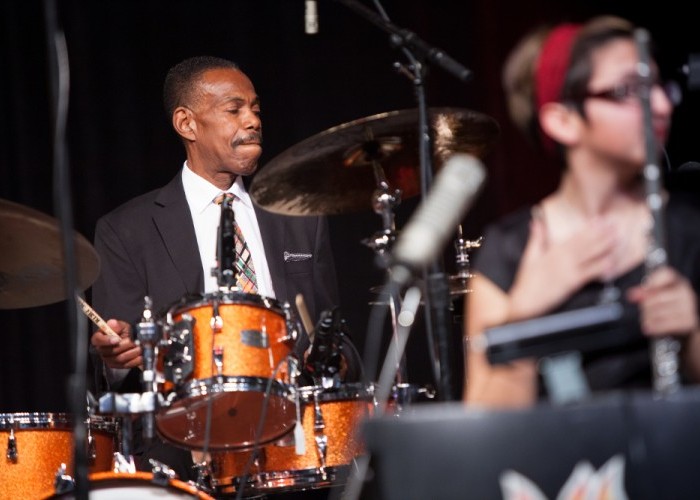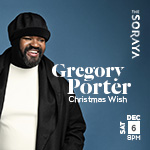Oct 28, 2025 10:47 AM
In Memoriam: Jack DeJohnette, 1942–2025
Jack DeJohnette, a bold and resourceful drummer and NEA Jazz Master who forged a unique vocabulary on the kit over his…

Leon “Ndugu” Chancler at the Jazz Education Network conference in San Diego on Jan. 16, 2015.
(Photo: Suzette Niess)In tribute to drummer Ndugu Chancler, who passed away on Feb. 3, below is the feature ‘Like Royalty,’ which was written by Frank Alkyer and published in the June 2015 issue of DownBeat.
This is the story of Leon “Ndugu” Chancler, a master of the drums. It is his first feature in DownBeat, which is easy to believe because a great deal of the 62-year-old’s work has been done behind the closed doors of recording studios. But it is also an inexplicable crime, a wrong that had to be righted, for Chancler’s drumbeat is the soundtrack of our times.
Harold Land, Gerald Wilson, Herbie Hancock, Freddie Hubbard, Miles Davis, Alice Coltrane, Carlos Santana, Weather Report&emdash;Chancler played with all of them … before he turned 22 years old.
Joe Henderson, Marvin Gaye, Eddie Harris, Patrice Rushen, George Duke, Jean-Luc Ponty, Earl Klugh, Labelle, Flora Purim, Gato Barbieri, Lalo Schifrin, the O’Jays, Ramsey Lewis, Stanley Turrentine, the Temptations, McCoy Tyner, Lionel Richie, Stanley Clarke, Donna Summer, Maynard Ferguson, the Crusaders, Kenny Rogers, Dianne Reeves, John Lee Hooker, Robbie Robertson, Joe Sample, Blind Boys of Alabama, Quincy Jones, Patti Austin and Joe Louis Walker—Chancler recorded with them and many more.
He co-wrote songs like “Dance Sister Dance” for Santana and “Let It Whip” for the Dazz Band. He provided that unforgettable, indelible beat on Michael Jackson’s “Billie Jean” for Thriller.
For the past 45 years and counting, Ndugu Chancler has brought grace and rhythm and soul to any and every musical setting in which he’s been placed. But he wants you to know that he is a jazz musician down to his core.
In December 2014 at the Midwest Band Clinic in Chicago, Chancler sat down with DownBeat Publisher Frank Alkyer to say exactly that during a live conversation. He told story after story about his life and times, and watched the jaws drop a little more with each famous name that crossed his lips. It became incrementally clearer to both music students and teachers alike in the crowd that they were listening to the wisdom of musical royalty.
This is Ndugu Chancler’s first feature in DownBeat. There was no space for questions, only Chancler’s wit, honesty and insight.
I remember going home and sitting at the dinner table and saying, “I want to be a musician,” and everyone laughing. I mean, you would’ve thought I was Richard Pryor.
The attraction for me in playing music wasn’t the blues, it wasn’t gospel music, it was jazz. It was jazz that I heard on the radio not being called “jazz” because on the radio stations I listened to at the time, they just played music. They played Horace Silver and Cannonball Adderley and Frank Sinatra and Sammy Davis, Jr. and Sam the Sham & The Pharaohs and Sly Stone and James Brown and Motown … . You had everything going at the same time.
I met Stix Hooper, who became one of the key figures in my life, period. Stix was with the Crusaders. They actually lived in my neighborhood [in Los Angeles], Wayne [Henderson] and Wilton [Felder]. I lived on 119th and Central. Wayne lived on 123rd. Wilton lived on 124th. By then, Joe Sample and Stix had moved [to] like 78th and 79th and Van Ness. But Wayne and Wilton lived in the neighborhood. I had this quasi-connection, and then I would see Stix and Wayne at the Watts Happening Coffee House, which was a place that had jam sessions on 103rd Street before the riots. I would see him there. So, now I’m starting to get close to the music.
Stix was the next guy doing everything in L.A., and it became a natural progression for me to follow in Stix’s footsteps. Stix played in Gerald Wilson’s Big Band; I ended up playing in Gerald Wilson’s Big Band. Stix was the drummer in the Crusaders; I replaced Stix as the drummer in the Crusaders. Stix played with Bobby Hutcherson and Harold Land; I played with Bobby Hutcherson and Harold Land&eamdash;all before I was 18 (laughs).
Bobby Hutcherson and Harold Land had a gig in Brookside Park out in Pasadena. A group that I played with—just some local guys, we weren’t very good—opened for Bobby Hutcherson and Harold Land. Stix had a chance to play my drums. Now, I had a real cheap drum set, and some real cheap cymbals—no name cymbals. You know, the music store puts their stamp on them. But I took pride in my drums, because I worked for and paid for these drums myself.
So Stix played on the drums, and after he played, he said, “Hey man, come by my house. You need some cymbals.” Stix gave me cymbals. Now that’s the first time anyone had ever given me anything. From there it became a whole mentoring thing. He told me what books to get, because I asked questions like, “Mr. Hooper, what do you think I should be doing?” He said, “Get stick control, get syncopation, get Podemski, get Advanced Techniques for the Modern Drummer, and you need to study out of these books.”
We had dialogue, and that’s when it started. From there, he kind of mentored me through the whole thing.
Those are a lot of the things that shake me into wanting to give back, because I couldn’t have gotten any of this on my own. Stix, Shelly Manne, Earl Palmer, Clarence Johnston [a drum teacher]: Those are the guys that gave me the tools that I needed on a day-to-day basis. The drummers.
I graduated from high school in 1970. I was 17. The same week of graduation, I opened Shelly’s Manne-hole with Gerald Wilson’s Big Band. Why do I remember that? Because that’s where I met [drummer] Paul Humphreys, and he took me for a ride in his Pantera. He came to Shelly’s Manne-hole. I mean, he didn’t know me, but the word was getting out: “There’s this new young guy who’s playing in Gerald Wilson’s Big Band, and he’s firing it up.” So, Paul Humphreys, who was doing a lot of sessions, I met him and Earl Palmer that same week. Again, they kind of took a liking to me, and just started giving me some words of wisdom. I remember Earl Palmer, the first thing he said is, “Man, you might end up being a recording drummer one day, so learn to work with a click track.” The first session I was on to do a recording that encompassed a click track was Marvin Gaye’s Trouble Man album. It was myself and, guess who, Stix Hooper. We were the two drummers.
Stix just did so much for me. Stix taught me about publishing. He taught me about managing and everything. I own my own songs, my books, everything. That’s what has given me, the luxury of surviving even during the lean times of being a jazz musician.
So, now I’m 19 and I’m playing with Freddie Hubbard. I’ve got confidence because I’ve played with Joe Henderson and Eddie Harris and Monk and all these other jazz guys, but now I’ve got the gig that I wanted. And I’m smoking on this gig. I’m smoking. I got Freddie Hubbard playing. He’s burning it, every night.
So we get to Buffalo, New York. Freddie Hubbard misses the first night. The band is there, but he’s not there. We’re at the Revilot in Buffalo, New York. The quartet plays. Smoked. Freddie Hubbard comes in the next night and everybody’s like, “Freddie, man, this band you got is smoking. This new drummer man, he’s hot.” Well, we played the first set, and we were killing. Played the second set, we were killing. Freddie Hubbard called me to his room and said, “Look here. You want to play like that, get your own band. Can’t have two stars in the same band. I’m Freddie Hubbard. This is my band. You’re fired.”
I moved back to L.A. I’m painting my bedroom, and all of the sudden I get this phone call [using a scratchy voice]: “You want to play with me?” [Audience laughs] Now, we used to joke on the phone, me and a few other musicians about us being Miles Davis to one another. So, I said, “Who is this?” “It’s Miles.” I said, “Yeah, right! Yeah, whatever.” He said, “You want to play with me?” Now I’m saying, “Oh, this is Miles.” And I don’t stutter, but I said, “Um, um—Mr. Davis—yeah, I want to play with you!”
He said, “Well get to New York!”
That was 1971. I did a European tour with Miles. Some people say, “The rest is history,” but that was the life changer because it was electric Miles. It was a great musician confirming that you don’t have to stay steeped in the traditional jazz thing to be a jazzer. Then, Miles Davis said, “You need to listen to James Brown and the Chambers Brothers, and Sly Stone and Jimi Hendrix,” whom I’d already been listening to, because I heard them on the radio with the ol’ Wolfman. So, it confirmed some of my inner spirits.

Jack DeJohnette boasted a musical resume that was as long as it was fearsome.
Oct 28, 2025 10:47 AM
Jack DeJohnette, a bold and resourceful drummer and NEA Jazz Master who forged a unique vocabulary on the kit over his…

D’Angelo achieved commercial and critical success experimenting with a fusion of jazz, funk, soul, R&B and hip-hop.
Oct 14, 2025 1:47 PM
D’Angelo, a Grammy-winning R&B and neo-soul singer, guitarist and pianist who exerted a profound influence on 21st…

To see the complete list of nominations for the 2026 Grammy Awards, go to grammy.com.
Nov 11, 2025 12:35 PM
The nominations for the 2026 Grammy Awards are in, with plenty to smile about for the worlds of jazz, blues and beyond.…

Jim McNeely’s singular body of work had a profound and lasting influence on many of today’s top jazz composers in the U.S. and in Europe.
Oct 7, 2025 3:40 PM
Pianist Jim McNeely, one of the most distinguished large ensemble jazz composers of his generation, died Sept. 26 at…

Drummond was cherished by generations of mainstream jazz listeners and bandleaders for his authoritative tonal presence, a defining quality of his style most apparent when he played his instrument unamplified.
Nov 4, 2025 11:39 AM
Ray Drummond, a first-call bassist who appeared on hundreds of albums as a sideman for some of the top names in jazz…






